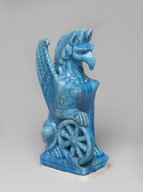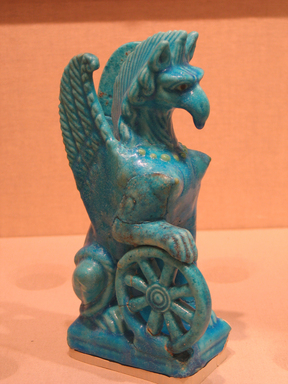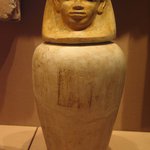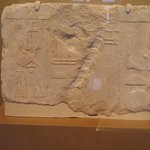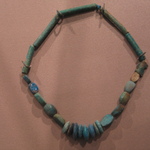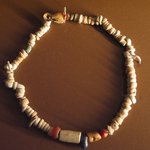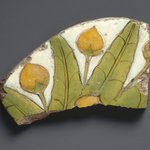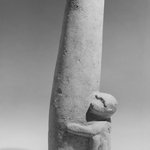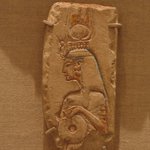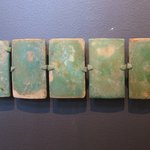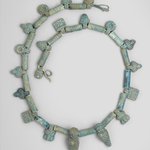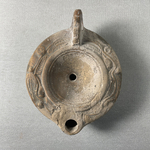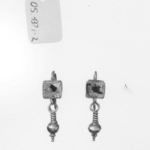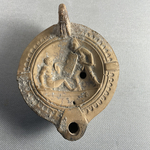Wow. How did the vase get this rich blue color?
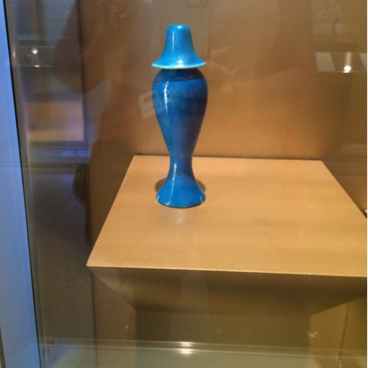
That is made of a really interesting material called faience, considered by Egyptologists as the first high-tech ceramic. The material is made of pure ground quartz, which has a dazzling, white look to it, which is why the ancient Egyptians called it tjehenet (dazzling). The quartz would have several other ingredients added to it; a small part of lime or calcium oxide and soda, all found in the rich desert sands and quarries in their landscape. These ingredients were either added to it before firing in the kiln, so that the beautiful blue would rise to the surface, or it would be put in a vessel of this powder so it would be coated from the outside while fired. Faience is glazed in many different shades of green and blue, which you'll see throughout the galleries.
Why is the Griffin of Nemesis blue?

That blue is a glaze on a material called faience, it was prized because it looked like even more expensive materials such as lapis lazuli, a blue stone, or turquoise. It's like a ceramic, made primarily from desert sand. Added minerals like copper create this vibrant blue when the piece is fired at extremely high temperatures. For the ancient Egyptians, the colors blue and green symbolized the color of water, vegetation, and thus health and life.
In mythology, Nemesis is a goddess who dealt out divine retribution for crimes or excessive pride, an avenger! The wheel may signify the constant turning of fate, with all its ups and downs, a wheel of fortune.
So blue!

Great find, that statuette is made of glazed faience, which is how that brilliant blue color is achieved.
Thanks, I had been wondering about the blue!
Cool! You will see it throughout the galleries as it was a popular and symbolic color to use in ancient Egypt. The ancient Egyptian word for the material Egyptologists call faience, tjehenet, means "brilliant" or "shining." Also, the color blue had special significance for the Egyptians: light shades of blue were associated with the sea and vegetation which represented health and life, and darker blues were associated with the dark primordial waters out of which creation first appeared, as well as the night sky through which the sun-god traveled to be reborn every morning.
Could you tell me how faience was made?

Faience is a man-made mixture of "ground quartz or quartz-sand held together by and alkaline binder. The bright and shiny surface
seen on this figurine is a result of glazing. The glaze was made of a form of powdered glass mixed with a liquid and applied either with a brush or by dipping the entire figurine.
It gets it's blue color from copper that is mixed into or applied to the surface of the quartz body before firing.
What is the glaze on this piece composed of? It's a very different blue from the others.

All of the objects in this case are made out of the same material: faience. But you're right, this one is glazed quite differently! Faience is a quartz-based paste that can be molded. In this case it was then coated in a copper-based glaze and fired at high temperature. The duller surfaced-objects were made by incorporated into the faience itself. The light blue color then came to the surface when the object was fired.
Ok, so it's just that the glaze is on the surface? I guess that would also make it more fragile?
Yes, applying the glaze to the surface does create a brighter and shinier final product. I'm not sure how it affects the integrity of the object though. The fired glaze does become vitrified which means it's quite hard and may even help hold the object together.
Could you tell me what this statuette is made of?

Of course! Like all the objects in this case, it is faience and this particular statuette was glazed to achieve both a brilliant and shiny surface. Faience is a paste made of powdered quartz and an binding agent. The paste is molded and then fired with varying surface treatments. This glaze uses copper-based pigment that turns bright blue when fired at high temperatures. The objects in the same case that have a duller surface quality were colored by incorporating copper into the paste itself. The blue then rises to the surface in the kiln. Faience is naturally sparkling white which you can see on some of the chipped surfaces!
Wow
Right! It's a quite "high-tech" material, but the Egyptians have been using it for a VERY long time. The tiles in this case come from the area of the first pyramid.
Is this material still used today in contemporary art and jewelry?

I know for a fact that simple necklaces of faience beads are are still made. They're largely marketed to tourists as "mummy beads" because they mimic some of the simpler necklaces mummies might be buried with. I'm not sure how much it is used in more contemporary design or modern Egyptian daily life.
Seems appropriate warning for our time! Any more info on this fascinating piece?
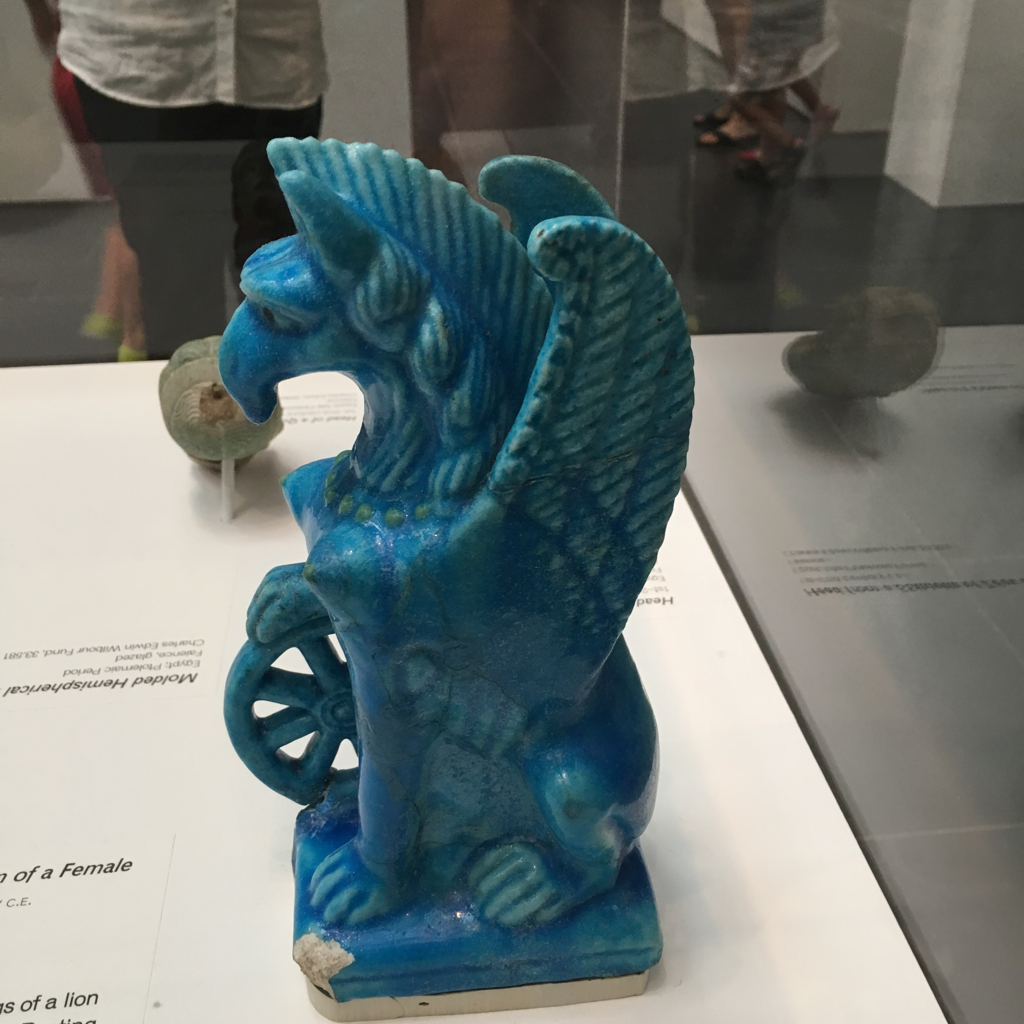
Sure! Nemesis, a Greek deity, also adopted by the Romans, comes to us, here, from an Egyptian context. Scholars suggest that the wheel is a symbol of the turning of fate. The ancient Egyptians, in their religion, put a high value on cosmic balance so it is not surprising that a deity concerned with maintaining equilibrium was quickly adopted in the Roman period!
How did this maintain its color?

The mineral color is fused to the faience itself as a result of the high firing temperature. Both the glaze and the faience are glass-like in nature and therefor bond easily at high temperatures. The mineral-based pigments are also quite stable.
Tell me more.

This is a statuette of Nemesis in the form of a female griffin and it is made of the popular Egyptian material, faience. What egyptologists call "faience" is made of a quartz-based paste that has been molded and fired at a high temperature. The bright shiny blue surface treatment is the result of glazing.
In mythology Nemesis is a goddess who dealt out divine retribution for crimes or excessive pride. The wheel may signify the constant turning of fate.
How was the glaze manufactured?

The glaze on this object was made of a form of powdered glass mixed with a liquid and applied with a brush or by dipping the entire figurine in at once. The pigment you see here would have been created with copper oxide and relied on the heat of the kiln.
If you notice the chipped edge of the sculpture however, you'll see that the white of the underlying faience is showing through indicating that the glaze is what leant the object it blue color.
Thanks
Is it Nemesis that is depicted on top of the Wheel of Fortune in Tarot cards (Rider and Thoth decks)?

They are related! The imagery on the Wheel of Fortune card can be traced back to Nemesis and a few other Classical sources.
According to Tarot historians, the wheel is attributed to Fortuna, a Roman goddess who combines the traits of Nemesis, Tyche, and Necessity.
Interesting!
Is nemesis an Egyptian or Roman god?

Nemesis is, in fact, a Roman deity that was adopted from the Greek tradition. This sculpture comes from the period when Rome ruled Egypt.
Is that where we got the English word nemesis?
Yes! Nemesis was concerned with retribution and indignation, in a way, a personification of resentment.
Her name in Greek translates to "dispenser of dues" and she was believed to be responsible for maintaining equilibrium amongst people.
Do you know what turns the copper oxide instead of green in this glaze?

The high heat of the kiln is an important factor in creating brilliant blue from the copper oxides in the case of these glazes. The faience material that this sculpture is made from is naturally sparkling white allowing and colored glazes to appear that much brighter.





